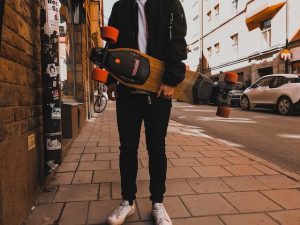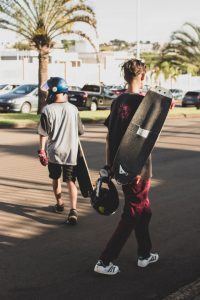We’re excited to guide you on this safety journey through the world of longboarding. Safety should always be a top priority whether you’re a seasoned longboarder or new to this.

Our safety guides cover topics such as proper equipment, how to prevent falls, and the importance of wearing protective gear. Additionally, we provide information on the different types of longboarding, tricks, and how to spot dangerous situations.
We’ll delve into the basics, such as the different types of boards (cruiser, freeride, downhill, etc.), the importance of protective gear (helmets, pads, etc.), advice on maintaining your board’s condition, and techniques for falling safely.
We’ll take you in practicing guides in safe environments, adhering to road rules and traffic signs, and being mindful of your surroundings.
So let’s buckle up for an exciting yet safe ride ahead! Remember, when we take care of ourselves, we can better serve others by setting a positive example.
Key Takeaways
From understanding longboarding basics to practicing in safe environments, it’s clear that safety is paramount for longboarding. By wearing safety gear, checking our boards regularly, learning how to fall safely, and obeying road rules, we can enjoy the thrill of the ride while minimizing risks.
As you embark on your journey of mastering the art of this sport, make sure to focus on the fundamentals, practice protection, and enjoy the ride! By keeping safety as the number one priority, mastering the basics of the sport, and ensuring that you have the right accessorizing items (like wheels, safety gear, and boards), you will be able to safely enjoy the thrill of the ride.
Let’s take these lessons to heart and make every adventure a great one! Let’s work together to create a safe and enjoyable longboarding experience for all!
Longboard Safety Guides
As you’re cruising down the street, it’s essential to understand the fundamentals of this sport. Balancing on a board and feeling the wheels hum beneath your feet is a sensation that all members of the longboarding community can appreciate. However, different types require varied riding techniques; mastering these is vital in ensuring safe practices for all.

They are available in a variety of shapes and sizes, each tailored to cater to distinct riding styles and types of terrain.
Longboard Types
- Cruiser– ideal for casual and comfortable longboarding
- Carving– built for tight and smooth longboard turns
- Downhill– built for stability during fast longboarding
- Freeride– versatile and commonly used in performing longboarding technical tricks
- Electric– with batteries and electric motors for effortless longboarding
- Hybrid– suits different longboarding styles and preferences.
The basics of longboarding include familiarizing its components (e.g., decks, wheels, trucks), styles (e.g., freestyle, downhill, slalom), and tricks (e.g., ollies, kickflips, shuvits). We must also be knowledgeable about balancing, cruising, and humming.
Understanding the basics is necessary to enjoy the activity safely and confidently.
Wearing Protective Gear
At FamilyHype, we recognize the importance of wearing safety gear in longboarding. It’s not just about preventing injuries, but also about building confidence and freedom on the board. Gear maintenance is key to preventing injuries. By using helmets, knee pads, wrist guards, and other safety gear, we can promote safe practices and set a great example for others.

Knowing our boards and how to ride them responsibly is crucial for creating a safe environment for everyone involved. We are already aware of the importance of wearing safety gear to minimize the risk of injury. As responsible longboarding, we must always prioritize this rule to achieve a fun and safe longboarding experience.
Check The Skateboard Condition
Now that we’ve highlighted the significance of protection, let’s discuss how to maintain our longboard’s condition for peak performance. When you skate, especially if you’re going downhill, it’s crucial to ensure your board is in the best condition. It is an important part of the family dynamic, and we want to ensure that it is used safely and properly. To ensure optimal functioning and worry-free enjoyment of the sport, it’s essential to take proper care of your longboarding through regular maintenance.
We suggest that you inspect it regularly for any damage, clean it after each session, and store it in a safe place. Always remember to wear a helmet and other safety gear when riding. These steps will help prolong the lifespan of your vehicle and keep it in top shape.
Before you set your foot on that board, it’s essential to give it a thorough once-over, ensuring every part is in top shape and ready to smoothly carry you through your next adventure. Board maintenance is key for safe performance.
Consider component upgrades if necessary. Components may include trucks, wheels, bearings, risers, decks, hardware, and grip tape. Familiarize yourself with each of these components so you can ensure they’re in good condition and give your thing the best performance. After all, we’re here to serve not just ourselves but others as well.
It is more than just a hobby – it’s a lifestyle. It’s important to stay safe, practice often, and enjoy the ride!
Learning How To Fall Safely
We all know that this sport is a fun activity, but is longboarding dangerous? Like many other action sports or physical activities, especially when reaching high speeds, it carries inherent risks, making it potentially dangerous when proper protection gear precautions are not observed. We already talked about wearing safety gear such as knee pads, and elbow pads, and checking the condition of your longboarding before riding.
Now let’s shift gears and discuss another critical aspect – learning how to fall safely. Falling properly is a skill that should be acquired before getting on the board. To stay safe, it’s important to practice falling on a flat surface with soft padding, such as grass or a foam pit. It’s also important to remember to tuck your arms and legs in when you fall so that you don’t injure yourself.
Mastering the art of falling safely while longboarding is just as important as learning to ride the board. We want to help you manage fear and prevent injuries, so we’ve developed some techniques to reduce impact and protect important parts of the body.
It’s not about eliminating falls–they’re part of the journey–but minimizing harm when they occur. After mastering these skills, it’s time to put them into practice in a safe environment.
Skateboarding In A Safe Environment
After you’ve gotten a handle on falling safely, it’s crucial to apply these skills and start practicing in an environment that minimizes hazards.

Here are some beginner guides for choosing safe locations and avoiding crowded areas:
- Choose longboarding safety locations, such as parking lots after hours or empty bike paths.
- Avoid crowded areas like busy streets or sidewalks during rush hour.
Remember, it is a sport, but safety comes first. Once you’re comfortable with the basics, you can start navigating the rules of the road and understanding traffic signs.
As you practice, be sure to take the necessary precautions to ensure that you’re able to do it safely and responsibly.
Longboarding Safety Gears
Following proper safety gear such as elbow and knee pads and ankle protectors, navigating the concrete jungle on your best longboard can be a thrilling yet intimidating experience. It’s crucial for everyone, especially those new to longboarding safety, to familiarize themselves with road rules and traffic signs, including stop signs and respecting pedestrian etiquette. Protection equipment tips like always giving pedestrians the right of way can’t be stressed enough.
Signaling turns is also of the utmost importance, and using slide gloves can help with signaling and protection during slides. As it’s the responsibility of riders to let others know their intentions, wearing wrist guards can also add an extra layer of protection for elbows during potential falls. In doing so, not only are longboarders protecting their skin, but they’re also serving others by creating a safer environment for everyone sharing the road, especially in low-speed situations and on open roads where the most important thing is to adhere to red lights and ensure the safety of all.
Conclusion
We’ve covered a lot, haven’t we? From understanding longboarding basics to practicing in safe environments, it’s clear that safety is paramount for longboarding. By wearing protective gear, checking our boards regularly, learning how to fall safely, and obeying road rules, we can enjoy the thrill of the ride while minimizing risks.
Let’s take these lessons to heart and make every adventure a safe one!
As you embark on your journey of mastering the art of this sport, make sure to focus on the fundamentals, practice protection, and enjoy the ride!
